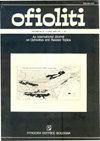西班牙Betic cordillera de baza蛇绿岩的岩石学、地球化学及成因
IF 1.3
4区 地球科学
Q2 GEOLOGY
引用次数: 0
摘要
在这项工作中,我们首次对Sierra de Baza蛇绿岩进行了岩石地球化学和成因研究,它代表了Betic Cordillera(西班牙南部)的蛇绿岩产状之一。它们由超镁铁质、基性和沉积岩组成,在阿尔卑斯造山运动期间受到海底和多期变质作用的很大影响。超镁质岩为蛇纹石化的辉长岩和辉长岩,变质辉长岩为变质玄武岩。总的来说,塞拉德巴扎蛇绿岩在地球化学上与其他贝提亚产的蛇绿岩以及西地中海(卡拉布里亚、内、外利古里德、普拉塔、科西嘉和西阿尔卑斯山)的其他特提斯蛇绿岩有着惊人的相似之处。其中变质岩的岩石学和地球化学特征与45 ~ 63oN之间大西洋脊的E-MORB岩浆活动相似,形成于超慢扩张脊条件下。这一过程在中生代时期形成了位于伊比利亚-欧洲边缘东南方的特提斯西端一条数百公里长的海底地带。中晚白垩世开始,欧洲-伊比利亚和非洲地球动力学应力状态的反转,导致部分在大陆边缘出土的洋片榴辉岩相发生俯冲变质作用,形成贝特蛇绿岩。这些蛇绿岩在Alboran大陆块体向南西移动的过程中被分离和肢解,逐渐与alapeca (Alboran、Kabilias、Peloritani、Calabria)微板块分离,最终占据了它们目前在北特内带的位置。本文章由计算机程序翻译,如有差异,请以英文原文为准。
Petrology, geochemistry and origin of the sierra de baza ophiolites (Betic cordillera, Spain)
In this work we present for the first time a petrological-geochemical and genetic study of the Sierra de Baza ophiolites, which represent one of theophiolitic occurrences of the Betic Cordillera (Southern Spain). They are composed of ultramafic, mafic and sedimentary rocks, largely affected bothby ocean floor and polyphasic metamorphism during the Alpine orogeny. Ultramafic rocks are serpentinized lherzolites and harzburgites, whereas themetabasites are meta-gabbros and meta-basalts. On the whole, Sierra de Baza ophiolites show striking geochemical similarities with those from otherBetic occurrences, as well as with other Tethyan ophiolites of the Western Mediterranean (Calabria, Internal and External Ligurides, Platta, Corsica andWestern Alps). In particular, metabasites show petrological and geochemical features similar to the E-MORB magmatism of the Atlantic Ridge between45 and 63oN generated under ultra-slow spreading ridge conditions. This process originated a strip of few hundreds km of ocean floor at the western endof the Tethys, located SE of the Iberian-European margin during the Mesozoic. The inversion of the stress regime in the European-Iberian and Africangeodynamics, starting from the Late-Middle Cretaceous, caused subduction and metamorphism in the eclogite facies of oceanic slices that were partiallyexhumed on the continental margin, forming the Betic Ophiolites. These ophiolites were disarticulated and dismembered as a result of the shift towardsSW of the Alboran continental block, progressively separated from the AlKaPeCa (Alboran, Kabilias, Peloritani, Calabria) microplate, finally occupyingtheir current position in the Betic Internal Zones.
求助全文
通过发布文献求助,成功后即可免费获取论文全文。
去求助
来源期刊

Ofioliti
地学-地质学
CiteScore
2.40
自引率
7.70%
发文量
1
期刊介绍:
Since 1976, Ofioliti provides an international forum for original contributions and reviews in the field of the geodynamics, petrology, geochemistry, biostratigraphy, stratigraphy, tectonics and paleogeography applied to ophiolitic terrains and modern oceanic lithosphere, including their sedimentary cover. Studies of topics such as geodynamics of the mantle, the evolution of orogens including ophiolites and paleoceanography are also welcome
 求助内容:
求助内容: 应助结果提醒方式:
应助结果提醒方式:


